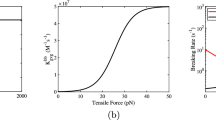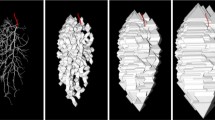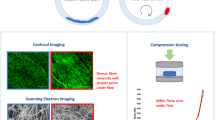Summary
Ultrastructural studies of thrombi were carried out on the common carotid artery of the rat using a method first described by Meng and Seuter (1977). Induction of thrombus formation in vivo was achieved by chilling of a small vessel segment under constant pressure and short-termed stasis. Disturbance of the blood flow was produced by a silver clip. The damaged vessel segments with the thrombotic deposits were removed 5, 10, 30 min, and 1, 4 and 24 h after stimulation of thrombosis. They were fixed and samples were studied as semithin and ultrathin sections morphologically using light and electronmicroscopy.
In the maturation of thrombi exact time intervals could be determined. The most important histopathological characteristics for age determination of arterial thrombi in the early period of thrombogenesis were the cross stripes of fibrin fibres. They appeared after 5 min, reaching a maximum after 10 min and disappeared as a result of increasing fibre density after 1 h. After 4 h nearly complete retraction of fibrin fibres was found which led after 24 h to the formation of a corresponding frame walling in the corpuscular elements. Apart from this aggregation of thrombocytes, which were of two different types were observed, one showing a fibrin-poor aggregate in which the thrombocytes appeared densely packed with numerous pseudopods, and one showing a thrombocyte poor aggregate with abundant interposed fibrin fibres. Agglutination of platelets which occurred in the thrombocyte-rich aggregate in the centre of the thrombus after 5 min led to thrombocytorrhexis after 30 min. The resulting cellular waste stimulated phagocytosis by mononuclear cells and leucocytes. Because of this a massive leucocytosis was found as a result of the early thrombocytorrhexis after 4 h. After 24 h the “viscous metamorphosis” in the fibrin-rich and in the fibrin-poor aggregate was largely completed. Clumping and deformation of erythrocytes was observed in the middle of the thrombus after 5 min and at the periphery of the thrombus after 24 h. Haemolysis did not occur within this time interval.
Zusammenfassung
In unserer ultrastrukturell durchgeführten Studie wurden Thromben in der Arteria carotis communis von Ratten nach einer zuerst von Meng und Seuter (1977) beschriebenen Methode experimentell erzeugt. Induktion der Thrombusbildung erfolgte in vivo durch Unterkühlung eines kleinen Gefäßabschnittes unter konstantem Druck und kurzfristiger Stase. Eine Änderung des Blutflusses wurde durch einen Silberclip erzeugt. Die geschädigten Gefäßsegmente einschließlich der Thromben bzw. deren Vorstufen wurden nach 5, 10, 30 min und 1, 4 und 24 h nach der Thrombosestimulation entnommen und fixiert. Semidünnschnitte und Ultradünnschnitte wurden im Licht- und Elektronenmikroskop morphologisch untersucht.
Den Transformationsvorgängen im Thrombus konnten exakte Zeitmarken zugeordnet werden. Als wichtigstes histopathologisches Merkmal für die Altersbestimmung arterieller Thromben in der Frühphase der Thrombogenese werteten wir die Querstreifung der Fibrinfasern. Diese trat bereits nach 5 min auf, erreichte nach 30 min ein Maximum und verschwand als Folge der zunehmenden Verdichtung der Fasern nach einer Stunde. Nach 4 h sahen wir eine weitgehende Retraktion der Fibrinfasern, die nach 24 h zur Bildung des Fibrinfasergerüstes mit Einmauerung korpuskulärer Elemente führte. Überdies beobachteten wir zwei Thrombocytenaggregate von differenter Struktur. Wir unterschieden ein fibrinarmes Aggregat, in dem die Thrombocyten dichtgepackt und pseudopodienreich erschienen von einem thrombocytenarmen Aggregat mit reichlich interponierten Fibrinfasern. Die nach 5 min im Zentrum des Thrombus auftretende Agglutination der Plättchen im thrombocytenreichen Aggregat führte nach 30 min zur Thrombocytorrhexis und ergab daher einen weiteren Anhalt für die Altersbestimmung des Coagulum. Der entstandene celluläre Abraum stimulierte mononucleäre Zellen und Leukocyten zur Phagocytose. Daher sahen wir nach 4 h eine massive Leukocytose als Folge der frühen Thrombocytorrhexis. Nach 24 h war die „viscöse Metamorphose“ im fibrinreichen und fibrinararmen Aggregat weitgehend abgeschlossen. Innerhalb des beobachteten Zeitraumes entstand eine Verballung und bizarre Deformierung der Erythrocyten, die bereits nach 5 min vom Zentrum des Thrombus ausging und nach 24 h die Peripherie erreichte. Eine Hämolyse der Erythrocyten war nach dieser Zeit noch nicht erkennbar.
Similar content being viewed by others
Literatur
Apitz, K.: Die Bedeutung der Gerinnung und Thrombose für die Blutstillung. Virchows Arch. Path. Anat. 308, 540–614 (1942)
Ballerini, G., Seegers, W.H.: A description of clot retraction as a visual experience. Thromb. Diath. Haem. 3, 147–164 (1959)
Barmeyer, J., Reindell, H.: Untersuchungen über die Kausalität der Koronarthrombose beim Herzinfarkt. Z. Kreislauff. 59, 219–225 (1969)
Benthaus, J.: Über die Retraktion des Blutgerinnsels. Thromb. Diath. Haem. 3, 311–352 (1959)
Berqvist, D., Arfors, K.E.: Red blood cells and initial haemostatic plug formation. Microvasc. Res. 12, 237–238 (1976)
Bleyl, U.: Morphologic diagnosis of disseminated intravascular coagulation ; histologic, histochemical and electronmicroscopic studies. Sem. Thromb. Haemost. 3, 247–267 (1977)
Brambel, Ch.E., Brambel, F.D.: Metal ions in platelet aggregation. Twelfth annual symposium on blood. Wayne State University, College of Medicine and Mayo Clinic 1964
Braunsteiner, H., Febvre, H.: Thrombocyten und Fibrinbildung im Elektronenmikroskop Acta Haematol. 3, 174–178 (1950)
Charter, B.V.: Platelet aggregation induced in vitro by therapeutic ultrasound. Thrombos. Haemostas. 38, 640–651 (1977)
De Robertis, E.: Electron microscope observation of the platelet-fibrin relationship in blood clotting. Blood 10, 528–533 (1955)
Doerr, W., Hoepker, W. W., Rossner, J. A.: Neues und Kritisches vom und zum Herzinfarkt. Sitzungsber. Heidelberger Akad. d. Wisschenschaften, math.-naturw. Kl. Jg. 1974, 4. Abh. Berlin-Heidelberg-New York: Springer 1974
Eberth, J.C., Schimmelbusch, C.: Experimentelle Untersuchungen über Thrombose. II. Die Entstehung von Thromben in größeren Gefäßen von Säugetieren. Virchows Arch. Path. Anat. 105, 331–350 (1886)
Frost, H.: Endothelschädigung und Abscheidung von Elementen des strömenden Blutes als initiales Geschehen in der Pathogenese der Arteriosklerose. Verh. Dtsch. Ges. Inn. Med., Schlegel, B. u. Bergmann, J.F. (Hrsg.), S. 1139–1145. München: Bergmann 1972
Gaarder, A., Laland, S.: Hypothesis for the aggregation of platelets by nucleotide. Nature 202, 909–910 (1964)
Gardlund, B., Hessel, B., Marguerie, G., Murano, G., Blombäck, B.: Primary structure of human fibrinogen. Characterization of disulfide-containing cyanogen-bromide fragments. Eur. J. Biochem. 77, 595–610 (1977)
Hall, C.E., Slayter, H.S.: The fibrinogen molecule: Its size, shape, and mode of polymerization. J. Biophys. Biochem. Cytol. 5, 11–15 (1959)
Hugues, J.: Agglutination précoce des plaquettes au cours de la formation du clou hémostatique. Thromb. Diath. Haem. 3, 177–186 (1959)
Hutter, R.V.P: Electron observation on platelets from human blood. Am. J. Clin. Pathol. 28, 447–460 (1957)
Irniger, W.: Histologische Altersbestimmung von Thrombose und Embolie. Virchows Arch. path. Anat. 336, 220–237 (1963)
Joergensen, L., Rowsell, H.C., Hovig, T., Mustard, J.T.: Resolution and organization of plateletrich mural thrombi in carotid arteries of swine. Am. J. Pathol. 51, 681–719 (1967)
Köppel, G.: Elektronenmikroskopische Untersuchungen zur Funktionsmorphologie der Thrombocyten und zum Gerinnungsablauf im normalen menschlichen Nativblut. Z. Zellforsch. 47, 401–439 (1958)
Koppel, G.: Die Umwandlung des Fibrinogens in Fibrin. Thromb. Diath. Haem. (Suppl.) VII, 7–219 (1962)
Leu, H.J.: Histologische Altersbestimmung von arteriellen und venösen Thromben und Emboli. Vasa 2, 265–274 (1973)
Lüscher, E.F.: Human fibrinogen. Bull. Schweiz Akad. Med. Wiss. 17, 153–161 (1961)
Lubnitzky, S.: Die Zusammensetzung des Thrombus in Arterienwunden in den ersten fünf Tagen. Med. Dissertation, Bern 1885
Marx, R.: Zur Kenntnis der für die Thrombusfestigkeit bedeutsamen Blutfaktoren; zugleich ein Beitrag zum Problem einer unspezifischen Blutstillungsförderung durch Transfusionen. Ber. 6. Tagg. dtsch, Ges. Bluttransfusion Köln 1957. Erg. Bluttransfusionsforsch. III, 147–153 (1957)
Meng, K.: Tierexperimentelle Untersuchungen zur antithrombotischen Wirkung von Acetylsalicylsäure. Ther. Ber. 43, 69–69 (1975)
Meng, K., Seuter, F.: Effect of acetylsalicylic acid on experimental induced arterial thrombosis in rats. Naunyn-Schmiedeberg's Arch. Pharmacol. 301, 115–119 (1977)
O'Brien, J.R.: A comparism of platelet aggregation produced by seven compounds and a comparism of their inhibitor. Am. J. Clin. Pathol. 17, 275–281 (1964)
Rinehart, J.F.: Electron microscope studies of sectioned white blood cells and platelets. Am. J. Clin. Pathol. 25, 605–619 (1955)
Rodman, N.F., Mason, R.G., McDevitt, N.B., Brinkhouse, K.M.: Morphologic alterations of human blood platelets during early phases of clotting. Am. J. Clin. Pathol. 40, 271–277 (1962)
Rodman, N.F., Painter, J.C., McDevitt, N.B.: Platelet disintegration during clotting. J. Cell Biol. 16, 225–242 (1963)
Sandritter, W., Beneke, G.: Thrombose. In: Handbuch der speziellen path. Anat., 11./12. Aufl. Kaufmann, E. und Staemmler, M. (Hrsg.). Berlin: de Gruyter 1969
Sinapius, D.: Beziehungen zwischen Koronarthrombosen und Myokardinfarkten. Dtsch. Med. Wochenschr. 97, 443–448 (1972)
Schmidt, R.: Eine neue Methode zur Erzeugung von Thromben durch Unterkühlung der Gefäßwand und ihre Anwendung zur Prüfung von ASS und Heparin. Inaugural-Dissertation, Gießen 1975
Schulz, H., Jürgens, R., Hiepler, E.: Die Ultrastruktur der Thrombocyten bei der konstitutionellen Thrombopathie (v. Willebrand. Jürgens) mit einem Beitrag zur submikroskopischen Orthologie der Thrombocyten. Thromb. Diath. Haem. 2, 300–323 (1958)
Seuter, F., Busse, W.D., Meng, K., Hoffmeister, F., Möller, E., Horstmann, H.: The antithrombotic activity of Bay 6575. Arzneim.-Forsch./Drug. Res. 29, 54–59 (1979)
Sommer, W.: Untersuchungen über den Ausgangswert der Komponente me (maximale Scherelastizität) im Thrombelastogramm. Inaug. Diss., München 1958
Spaet, T.H.: Studies in the in vivo behavior of blood coagulation product I in rats. Thromb. Diath. Haem. 8, 276–285 (1962)
Turitto, V., Baumgartner, H.: Platelet interaction with subendothelium in a perfusion system. Physical role of the red blood cells. Trans. Am. Soc. Artif. Intern. Organs 21, 593–601 (1975)
Virchow, R.: Thrombose und Embolie. Gesammelte Abhandlungen zur wissenschaftlichen Medizin. Frankfurt a.M.: Meidinger 1856
Author information
Authors and Affiliations
Additional information
Herrn Prof. Dr. Dres. h.c. Wilhelm Doerr, Heidelberg, zum 65. Geburtstag in dankbarer Verehrung gewidmet
Frau Antoni, Herrn Ing. grad. Derks und Herrn Rieger sei für ausgezeichnete technische Assistenz herzlichst gedankt.
Rights and permissions
About this article
Cite this article
Hofmann, W., Rommel, T., Schaupp, T. et al. Transformationsvorgänge in der Frühphase der Entstehung des arteriellen Thrombus. Virchows Arch. A Path. Anat. and Histol. 385, 151–168 (1980). https://doi.org/10.1007/BF00427401
Received:
Issue Date:
DOI: https://doi.org/10.1007/BF00427401




